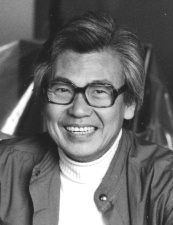Wen-Ying Tsai
| Wen-Ying Tsai | |
|---|---|

Tsai in the 1970s
|
|
| Born |
Wen-Ying Tsai October 13, 1928 Xiamen, China |
| Died | January 2, 2013 (aged 84) Manhattan, New York City |
| Nationality | American |
| Education | University of Michigan, Art Students League, New School for Social Research. |
| Known for | Sculpture, Cybernetic art, Kinetic art, Interactive art |
| Notable work | US Patent #4,265,402 (for Upward Falling Fountain); Japan Patent #1299159 (for Strobe Liquid Display Device) |
| Movement | Art, Science, and Technology |
| Awards | John Hay Whitney Fellowship for Painting, 1963 Edward MacDowell Fellowship, 1965 Second Prize, Experiments in Art and Technology (E.A.T.), Museum of Modern Art, New York, 1968 Fellow, Center for Advanced Visual Studies, Massachusetts Institute of Technology, 1969 Best Fine Art in Steel, American Iron and Steel Institute, 1971 ARTEC Grand Prix, Second International Biennale, Nagoya, Japan, 1991 Alumni Merit Award, University of Michigan, 2001. |
| Patron(s) | Howard Wise Gallery, Denise René Gallery, David Bermant Foundation |
Wen-Ying Tsai (October 13, 1928 – January 2, 2013) was an American pioneer cybernetic sculptor and kinetic artist best known for creating sculptures using electric motors, stainless steel rods, stroboscopic light, and audio feedback control. As one of the first Chinese-born artists to achieve international recognition in the 1960s, Tsai was an inspiration to generations of Chinese artists around the world.
Wen-Ying Tsai was born in Xiamen, Fujian Province, China and emigrated to the United States in 1950, where he attended the University of Michigan, receiving a Bachelors in Mechanical Engineering (BSME) in 1953. Moving to New York City after graduation, Tsai embarked on a successful career as an architectural engineer working for clients such as Walter Gropius, Mies van der Rohe, Synergetics, and Skidmore, Owings and Merrill. While working as an engineer by day, Tsai pursued artistic studies at the Art Students League at night, while also taking courses in political science and economics at the New School for Social Research. Tsai also attended modern dance classes with Erick Hawkins.
In 1963, Tsai won a John Hay Whitney Fellowship for Painting, after which he decided to leave engineering and devote full-time to the arts. After a three-month trip in Europe, he returned to New York and began to make three-dimensional constructions using optical effects, fluorescent paints, and ultra-violet light. These wary works were later selected for The Responsive Eye, an exhibition curated by William Seitz at the Museum of Modern Art in New York.
...
Wikipedia
